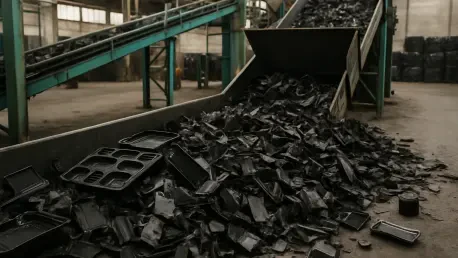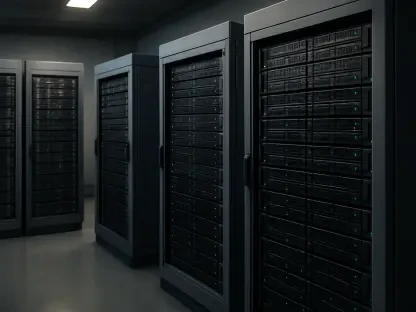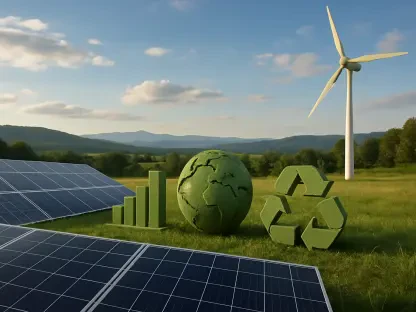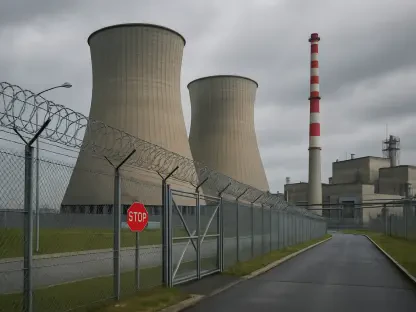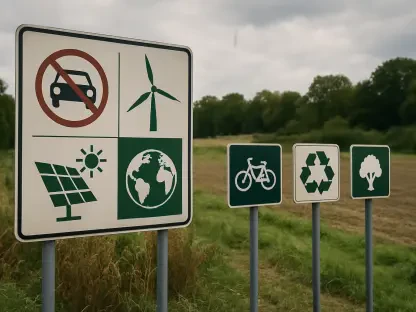What if the takeout container holding tonight’s dinner is destined for a landfill, no matter how diligently it’s tossed into the recycling bin? Black rigid plastics—those ubiquitous trays, lids, and tubs—comprise a staggering portion of household waste, yet most escape the recycling loop. Despite their everyday presence in kitchens and cafes across the United States, these dark materials remain a persistent thorn in the side of sustainability efforts. This pervasive issue raises a pressing question: can cutting-edge technology finally turn the tide on a material long deemed unrecyclable, or will systemic barriers continue to block progress? The stakes are high as environmental concerns mount and consumer frustration grows over recycling’s broken promises.
Why Black Rigid Plastics Languish in Landfills
Black rigid plastics, commonly found in food packaging and household items, are often overlooked in the recycling process. Their dark hue, imparted by carbon black pigment, renders them invisible to the near-infrared (NIR) optical sorters used in most materials recovery facilities (MRFs). As a result, these plastics slip through the cracks, frequently ending up as waste rather than being transformed into new products. This persistent challenge has earned them a reputation as the outcast of recyclable materials, frustrating both consumers and industry professionals alike.
The impact of this issue extends beyond mere inconvenience. With millions of pounds of black plastics discarded annually, their exclusion from recycling streams contributes significantly to landfill accumulation and environmental degradation. Data from waste analysis firm Greyparrot reveals that 55% of black plastic by mass is lost to disposal streams in current systems, underscoring the scale of the problem. This statistic highlights a critical gap in recycling infrastructure that demands urgent attention.
Compounding the problem is the lack of awareness among the public about the recyclability of these items. Many households continue to place black trays and lids in curbside bins, unaware that most programs exclude them due to sorting limitations. This disconnect between intention and outcome fuels broader skepticism about recycling efficacy, pushing the need for innovative solutions to bridge the gap between consumer behavior and system capabilities.
The Core Challenges in Sorting Black Plastics
At the heart of the recycling struggle lies a technological barrier: standard NIR sorters fail to detect black plastics against the dark conveyor belts in MRFs. This invisibility means that even when collected, these materials are often misidentified as residue and discarded. The limitation has led many curbside programs to outright reject black plastics, leaving municipalities and waste managers grappling with an ever-growing pile of unprocessed waste.
Beyond sorting issues, the economic viability of recycling black plastics remains a significant hurdle. Even when successfully captured, the lack of robust end markets for recycled black resins discourages investment in recovery efforts. Industry experts note that recovered black plastics are typically downgraded to low-value industrial products like pipes or crates, rather than returning to high-demand packaging applications, further diminishing their appeal to recyclers.
Environmental concerns add another layer of complexity to the dilemma. Carbon black, the pigment responsible for the dark color, is flagged as a potential health hazard in its raw form and interferes with recycling by absorbing NIR wavelengths. Initiatives like the U.S. Plastics Pact aim to phase out such problematic materials by 2030, but until alternatives gain traction, black plastics continue to pose a multifaceted challenge to achieving a circular economy.
Technological Innovations Offering New Hope
Amid these challenges, a wave of technological advancements is sparking optimism for black plastic recycling. Innovations such as laser object detection (LOD), mid-infrared (MIR) spectroscopy, artificial intelligence (AI), and computer vision are being developed to overcome the limitations of traditional sorting systems. Companies like Tomra and Machinex are at the forefront, with WM investing $39 million in Tomra Autosort systems at its Germantown, Wisconsin facility to enhance detection capabilities for black materials.
Pilot programs are already yielding promising results. At Rumpke’s Columbus, Ohio MRF, Machinex’s AI-driven sorting technology has achieved recovery rates of up to 85% for black plastics, a significant leap from previous capabilities. However, these systems often struggle to differentiate between polymer types within black plastics, such as polypropylene or polyethylene terephthalate, limiting their ability to create high-quality recycled streams for specific uses.
Despite the potential, widespread adoption of these technologies faces hurdles. High costs and the slow pace of scaling innovations across thousands of MRFs nationwide temper enthusiasm. While these tools represent a critical step forward, their integration into standard operations remains constrained by both financial considerations and the need for stronger market demand for recycled black materials, pointing to a complex road ahead.
Industry Perspectives on Progress and Pitfalls
Insights from industry leaders shed light on the evolving landscape of black plastic recycling. Brent Bell of WM emphasizes the rapid advancements in sorting technology, noting that capabilities have come “a long, long way” in a short span of time. This progress is evident in facilities where upgraded systems are beginning to capture materials previously deemed unsortable, offering a tangible shift in operational outcomes.
Yet, economic challenges persist, as highlighted by Emily Friedman of ICIS, who points to the weak end markets for recycled black resins. The oversupply of cheap virgin plastics continues to undercut the value of recycled materials, discouraging MRF operators from prioritizing black plastic recovery. This sentiment is echoed by recyclers like Jeff Snyder of Rumpke, who remain cautious about promoting collection without assured buyers.
On a brighter note, companies like KW Plastics demonstrate that demand exists in niche sectors, processing around 100 million pounds of black postconsumer resins annually for industrial applications. Meanwhile, Gaspard Duthilleul of Greyparrot advocates for systemic collaboration, urging stakeholders to align packaging design with recovery capabilities through data-sharing platforms like Deepnest. These voices collectively underscore the need for a multifaceted approach that marries technological gains with economic and design reforms.
Actionable Strategies to Transform Recycling Outcomes
Addressing the black plastic crisis requires coordinated efforts across the recycling value chain. Brands can play a pivotal role by transitioning to lighter, more recyclable colors, as seen with companies like Sam’s Club and SC Johnson, who have redesigned packaging to enhance compatibility with existing sorting systems. Such upstream changes reduce the burden on downstream recovery processes and signal a commitment to sustainability.
Policy initiatives, such as extended producer responsibility (EPR) laws, offer another avenue for progress. By incentivizing demand for recycled materials, these regulations—already in effect in states like Oregon—could stimulate markets for black plastics if tailored to include colored resins. Policymakers and industry advocates must work together to ensure that such frameworks address the unique challenges of materials often left behind in recycling efforts.
Finally, collaboration through data-sharing tools can bridge gaps between packaging producers, brands, and recyclers. Platforms like Greyparrot’s Deepnest provide critical insights into material fate within recycling streams, enabling informed design decisions. Meanwhile, MRF operators are encouraged to pilot advanced sorting technologies, even amidst economic constraints, to build the infrastructure needed for long-term success. These strategies collectively pave the way for a more inclusive recycling system.
Reflecting on a Path Forward
Looking back, the journey of black rigid plastics through the recycling maze reveals a landscape marked by persistent obstacles and burgeoning hope. Technological strides have begun to crack open doors once firmly shut, with innovations like AI and laser detection proving their worth in pilot programs. Industry voices have echoed a shared resolve to push beyond economic and design barriers, while brand shifts toward recyclable hues hint at changing tides.
Yet, the road ahead demands more than isolated fixes. Stakeholders across the spectrum need to rally around systemic solutions—forging stronger end markets, aligning packaging with recovery systems, and leveraging policy to drive demand. Investing in scalable tech at MRFs stands as a critical next step, alongside continued collaboration via data platforms to refine upstream choices. Only through such unified action can the shadow over black plastics lift, transforming a notorious waste stream into a valued resource for a sustainable tomorrow.
